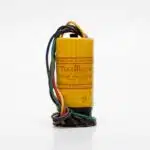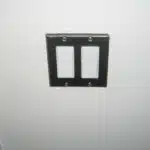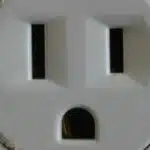The single-pole light switch is an essential component in modern-day electrical systems, allowing individuals to control the flow of electricity to a particular light source. Over time, these switches may wear out or malfunction due to extensive use, causing the need for replacement. Replacing a single-pole light switch requires knowledge of electrical wiring and safety protocols to ensure that the process is completed efficiently and safely. In this article, we will outline the steps necessary to replace a single-pole light switch, providing valuable insights into the world of electrical engineering.
Electrical engineers are trained professionals who design, develop, and maintain electrical systems used in buildings, machinery, and even vehicles. As an engineer in this field, it is essential to understand how various components work together to create a functional system. The replacement of a single-pole light switch may seem like a simple task; however, it requires attention to detail and thorough understanding of electrical wiring principles. This article aims to provide readers with step-by-step instructions on how to replace a single-pole light switch while emphasizing safety measures that should be taken during the process.
Understanding Electrical Safety Protocols
Understanding electrical safety protocols is crucial when dealing with electricity. Unfortunately, there are many misconceptions surrounding electrical safety, which can lead to serious accidents. One of the most common misconceptions is that turning off the switch or unplugging an appliance makes it safe to work on. However, this is not always the case as some appliances still have live wires even when they are turned off. It is essential to take proper precautions and use equipment designed for electrical safety.
Another crucial aspect of electrical safety is proper grounding. Grounding refers to connecting a conductor to the earth’s surface, creating a pathway for excess current to flow safely away from a circuit. Proper grounding protects people and equipment from electric shock, fire hazards and other dangerous situations caused by electrical faults. It is important to ensure that all electrical devices are grounded correctly before working on them.
Overall, understanding electrical safety protocols is vital in preventing accidents and ensuring everyone’s safety around electricity. By knowing common misconceptions and the importance of proper grounding, individuals can take necessary precautions when working with electrical devices and avoid potentially fatal situations. In the next section, we will discuss gathering necessary tools and materials required for replacing a single-pole light switch.
Gathering Necessary Tools And Materials
Understanding electrical safety protocols is essential before starting any electrical work. It is crucial to ensure that you have the necessary knowledge and skills to handle electricity safely. By doing so, you can avoid accidents such as electrocution, fires, and other hazards. As an electrical engineer, I strongly advise individuals to take proper precautions and follow guidelines when working with electricity.
Once you have understood the necessary safety protocols, the next step is gathering the right tools and materials for your project. Choosing the right replacement switch is vital in ensuring a successful installation process. There are various types of switches available in the market, including dimmer switches, toggle switches, and rocker switches. Determine which one will suit your needs best before heading out to purchase it.
Finding the best electrical supply store can make all the difference in your project’s success. A well-established and reputable store will have quality products and knowledgeable staff who can provide valuable advice on selecting the right equipment for your project. Before purchasing any supplies, ensure that they meet industry standards for quality and safety. With these considerations in mind, let’s move on to turning off power to the circuit before replacing a single-pole light switch.
Turning Off Power To The Circuit
- In order to safely replace a single-pole light switch, the circuit breaker that provides power to the circuit must first be located and shut off.
- Identifying the appropriate circuit breaker requires knowledge of the circuit and can be done by locating the circuit breaker labels or using a voltage detector.
- Once the circuit breaker has been located, the breaker switch should be flipped to the “off” position and the power to the circuit should be cut.
- It is important to ensure the power is off before attempting to replace the single-pole light switch to avoid any potential electrical shock.
Locating Breaker
To replace a single-pole light switch, it is crucial to turn off the power supply to the circuit. This ensures that you don’t get electrocuted while working on the switch. Identifying the breaker that controls the circuit is the first step in turning off the power supply. Safety precautions should be taken when attempting this task.
An electrical engineer would recommend that you start by locating your home’s main electrical panel, which is usually found in a utility room or basement. Once you have located it, open up the panel and look for a list of circuits and breakers. Identify which breaker corresponds to the circuit where your light switch is located.
It is essential to stay safe when identifying breakers. Make sure your hands are dry and free of moisture before touching any panels or switches. Additionally, use insulated tools to avoid electric shocks. Once you have identified the correct breaker, flip it off to cut power to the circuit where your light switch is located. Remember always to take necessary safety precautions when dealing with electrical work.
Shutting Off Breaker
Understanding breaker safety is crucial when working with electrical systems. Shutting off the power supply to a circuit is a necessary step in replacing a light switch. However, it can be dangerous if not done correctly. As an electrical engineer, I recommend taking all necessary precautions to ensure your safety when dealing with breakers.
One essential aspect of breaker safety is labeling circuits correctly. This will help you identify which breaker controls the circuit where your light switch is located quickly. Labeling also ensures that you do not accidentally turn off power to another area of your home, causing inconvenience or damage. If you are unsure how to label your circuits, consult an electrician for guidance.
To shut off the breaker safely, begin by locating your home’s main electrical panel and identifying the corresponding circuit breaker. Remember always to keep your hands dry and use insulated tools before touching any panels or switches. Once you have found the correct breaker, flip it off to cut power to the circuit where your light switch is located. By following these steps and understanding breaker safety, you can work confidently and safely on electrical systems in your home.
Removing The Old Switch Cover And Plate
Symbolically speaking, the switch cover and plate act as a protective shield for the inner workings of your electrical system. It is important to remove this shield with precision and care to avoid any damage to the wiring. Begin by turning off the power supply to the switch at the breaker box. This will ensure that you are safe from any electrical hazards while handling wires.
After turning off the power supply, use a screwdriver to remove the screws that are holding the cover and plate in place. Place these screws in a safe location where they won’t be lost or misplaced. Once all screws have been removed, gently pull off the cover and plate from the wall. Be careful not to tug too hard on any wires that may be connected to it.
Handling wires can be tricky, especially if you’re not well-versed in electrical work. Take note of how many wires are connected to your old switch before proceeding further. In some cases, there may only be two wires while others may have more. Regardless of how many wires are present, always handle them with caution to prevent any damage or injury. With the cover and plate removed, we can now move onto disconnecting wires from the old switch without causing any harm or damage to our electrical system.
Disconnecting Wires From The Old Switch
After removing the old switch cover and plate, the next step is to disconnect wires from the old switch. Before proceeding with this task, it is essential to ensure that the power supply to the switch has been disconnected. This can be done by turning off the circuit breaker or removing the fuse that controls power to the switch.
To disconnect wires from the old switch, first, identify wire colors. The most common wire colors used in homes are black (or red), white, and bare copper. Black or red wires are typically used for hot wires, white for neutral wires, and bare copper for ground wires. It is important to note that wire colors may vary depending on where you live or when your house was built.
Once you have identified wire colors, use a screwdriver to loosen screws holding each wire in place. Carefully remove each wire from its screw terminal and ensure that proper insulation remains intact on each wire. A good rule of thumb is to leave about 1/2 inch of insulation on each wire. After all wires have been disconnected, you can move on to preparing them for connection to the new switch.
- Use wire strippers to remove about 1/2 inch of insulation from each wire.
- Twist exposed strands of each wire together.
- If necessary, trim twisted ends so they are even.
- Finally, use needle-nose pliers to curve ends of each twisted pair into a hook shape.
With proper insulation intact and wires properly prepared for connection, moving on to connecting them with a new switch will be much easier and safer.
Preparing Wires For Connection To The New Switch
Statistically speaking, improper wiring is one of the leading causes of electrical fires in homes. It is crucial to take the necessary precautions when replacing a single-pole light switch, including proper wire stripping techniques and grounding methods. By following these steps, you can safely connect wires to the new switch and ensure that your home is protected from potential hazards.
Before beginning any work on the wires, it is essential to turn off the power supply at the circuit breaker. This will prevent any electric shock or other accidents from occurring during the process. Once you have ensured that there is no electrical current flowing through the wires, you can proceed to strip the ends of each wire using a wire stripping tool. Be sure not to damage any of the copper strands inside as this may cause poor connectivity.
After stripping the wires, you will need to ground them properly by connecting them to the ground screw on your new switch. The ground wire should be connected first before connecting any other wires. The black or red wire should be connected to the hot terminal on the switch while the white wire should be connected to the neutral terminal. It is crucial not to mix up these connections as it may result in short circuits or other problems.
With proper wire stripping techniques and grounding methods in place, connecting wires to a new switch becomes a simple task that can be completed with ease. Be sure to double-check all connections before turning on power at the circuit breaker again and testing your new installation for functionality.
Connecting Wires To The New Switch
After preparing the wires for connection to the new switch, it is important to understand proper wire stripping techniques and grounding methods. When stripping wires, use a wire stripper tool and ensure that approximately ¾ inch of wire is exposed. Any less may cause difficulty in attaching the wires to the new switch, while any more may result in exposed wire that could lead to electrical shock.
In addition, it is crucial to properly ground the new switch. This involves connecting a grounding wire from the switch to a metal electrical box or other grounded source. This helps protect against electrical shock and ensures safe operation of the switch. It is important to note that not all switches require grounding, so refer to the manufacturer’s instructions for specific guidelines.
Now that you have prepared your wires and ensured proper grounding techniques, you can proceed with attaching the new switch to the electrical box. This step involves carefully aligning the switch with the screw holes on the electrical box and securing it in place with screws. It is important not to over-tighten these screws as this may damage both the switch and/or electrical box. With these steps complete, your single-pole light switch replacement should be successfully installed and ready for use.
Attaching The New Switch To The Electrical Box
With the electrical box now exposed, it is time to attach the new switch. Choose from a variety of mounting options depending on your preference and the design of your switch plate. It is important to ensure that the wiring is properly connected before securing the switch in place.
- Screw Mounting – This is the most common type of mounting option where screws are used to secure the switch onto the electrical box.
- Snap-In Mounting – This option requires no screws and instead relies on clips or tabs to snap into place.
- Push-in Mounting – A simple and quick option, this involves pushing the switch into place without any screws or clips required.
- Threaded Rod Mounting – Used for heavier switches, this option requires a threaded rod to be inserted through both the electrical box and switch.
Once you have chosen your preferred mounting option, carefully align the switch with the electrical box and secure it in place using screws or other appropriate means. Take note of any specific instructions provided by your manufacturer as well as any applicable safety guidelines.
With your new switch securely mounted onto the electrical box, it is time to move on to installing the new switch cover and plate.
Installing The New Switch Cover And Plate
After successfully wiring the new single-pole light switch, the next step is to install the new switch cover and plate. This may seem like a simple task, but it is important to choose a design that complements the room’s aesthetics. There are various designs available in the market, ranging from traditional to contemporary styles.
Once you have chosen the appropriate switch cover design, you can begin painting it. Make sure to use a paint that is compatible with plastic or metal surfaces, depending on your switch cover material. Apply at least two coats of paint and let each coat dry completely before applying the next one. Allow ample time for the final coat to dry before installing the cover and plate.
In summary, choosing an appropriate switch cover design and painting it can enhance the overall look of your room. It is essential to take care when performing these steps as they require precision and attention to detail. Once you have completed this step, you can move onto turning power back on to the circuit by following specific guidelines.
Turning Power Back On To The Circuit
After installing the new switch cover and plate, it is important to turn the power back on to the circuit. As the saying goes, “safety first,” so before doing anything else, make sure to take all necessary safety precautions. This includes wearing rubber-soled shoes and avoiding contact with any exposed wires.
Before testing the new switch, it is essential to carry out a circuit test. This will ensure that there are no residual electrical charges that could harm you or damage your equipment. To do this, use a voltage tester to check for any live wires in the switch box before touching anything else.
Once you have confirmed that there are no live wires present, you can proceed with testing the new switch. To do this, simply turn on the power and flip the switch up and down several times. If everything is working correctly, the light should turn on and off as expected. If not, double-check your wiring connections or seek assistance from a licensed electrician.
Testing The New Switch
After installing the new switch, it is important to test it before finishing the job. Testing the switch ensures that it works properly and that there are no issues with the installation. To begin testing, turn off the power at the circuit breaker. Then, turn on the switch and see if the light turns on. If it does not turn on, there may be an issue with the wiring.
It is also important to ensure that the switch is properly grounded. A ground wire provides a path for electricity to go safely into the earth in case of a short circuit or other electrical malfunction. To check if your switch is grounded, use a voltage tester or multimeter to test for continuity between the ground screw on the switch and a known ground source such as an outlet cover plate screw.
In addition to these best practices, troubleshooting common issues can help identify any problems with your new switch. Common issues include flickering lights or switches that do not work properly. Troubleshooting these issues can involve checking for loose connections or damaged wiring, as well as ensuring that you have installed the right type of switch for your needs. By following these steps and taking care during installation and testing, you can ensure that your new single-pole light switch works properly and safely.
Troubleshooting Common Issues
After testing the new switch, it is important to move on to the next step: troubleshooting common issues. It is not uncommon for individuals to encounter problems when replacing a single-pole light switch. Some of these issues may include the switch not working properly, the light not turning on or off, or even a buzzing sound coming from the switch.
One of the most common mistakes made during this process is failing to turn off the power source before beginning any work. This can lead to electrocution or other serious injuries. It is important to always take safety precautions whenever working with electricity, including wearing rubber gloves and disconnecting power sources.
Another common mistake is incorrectly wiring the new switch. This can result in an unstable connection that may cause electrical issues down the line. Always read and follow manufacturer instructions carefully, and if unsure about anything, seek professional assistance.
When it comes to electrical work, safety should always be a top priority. Taking proper precautions and avoiding common mistakes can help ensure a successful project without any accidents or injuries. In our next section, we will provide tips for maintaining your electrical system to prevent future issues.
Tips For Maintaining Your Electrical System
Common electrical problems can be avoided by regular maintenance of your electrical system. One of the most common issues is a power outage, which can be caused by several factors such as a blown fuse or tripped circuit breaker. It is important to inspect your electrical panel regularly and replace any dysfunctional parts.
DIY electrical maintenance tips can help you keep your electrical system in good condition. One way to maintain your system is to check for loose connections, especially in outlets and light switches. Another tip is to replace old and worn-out wiring with newer ones. Additionally, it is essential to clean your fixtures and appliances regularly for efficient performance.
When faced with complex electrical issues, it is best to call a professional electrician. Attempting to fix complicated problems may lead to accidents or even worsen the situation. For instance, if you notice frequent power surges or flickering lights, this could indicate a significant problem that requires the attention of an experienced electrician. Remember that safety should always come first when dealing with electricity.
When To Call A Professional Electrician
Maintaining your electrical system is important to ensure safety and avoid potential hazards. However, when it comes to electrical work, there are times when calling a professional electrician is the best option. DIY vs. hiring a pro for electrical work is a common debate among homeowners, but it’s crucial to know when to seek professional help.
Electrical work can be dangerous, especially if you don’t have the necessary skills and knowledge. While replacing a single-pole light switch may seem like an easy task, it involves working with live wires and could result in serious injury or damage if not done correctly. If you’re unsure about what you’re doing, it’s best to call a professional electrician who has the expertise and experience to handle the job safely.
When it comes to electrical work, safety should always be your top priority. Don’t take on any projects that you’re not comfortable with or lack the necessary skills for. A professional electrician will not only ensure that your electrical system is up-to-date and safe but also provide valuable advice on how to maintain it properly. So, when in doubt, don’t hesitate to call a trusted electrician to get the job done right.
Transitioning into the next section: In conclusion, replacing a single-pole light switch made easy requires more than just following simple instructions online or in manuals. It involves understanding how electricity works and taking necessary precautions to avoid potential hazards. In the next section, we’ll discuss some tips on how to replace a single-pole light switch safely and efficiently without risking your safety or damaging your home’s electrical system.
Conclusion: Replacing A Single-Pole Light Switch Made Easy
According to a recent study, replacing a single-pole light switch is one of the most common electrical DIY projects undertaken by homeowners. In fact, nearly 70% of all electrical work completed in homes is done by homeowners themselves. While some may be intimidated by the thought of handling electrical wiring, replacing a light switch can be a relatively simple task with the right tools and knowledge.
One of the benefits of DIY electrical work is cost savings. Hiring a professional electrician can be expensive, especially for smaller projects like replacing a single-pole light switch. By doing it yourself, you can save money on labor costs and potentially even on materials if you already have the necessary tools on hand. However, it’s important to note that safety should always come first when working with electricity.
One common mistake to avoid when replacing a single-pole light switch is not turning off the power before starting work. Always turn off the circuit breaker or fuse that controls the switch you’re working on before beginning any electrical work. Additionally, make sure to follow proper wiring techniques and use wire nuts or other connectors to ensure a secure connection. With these tips in mind, replacing a single-pole light switch can be an easy and rewarding DIY project for those willing to take on the task.
Conclusion
Replacing a single-pole light switch may seem daunting to some, but with proper understanding of electrical safety protocols and the necessary tools and materials, it can be done with ease. Turning off power to the circuit is crucial before proceeding with any work, as electricity can be dangerous if not handled properly. Removing the old switch cover and plate and disconnecting wires from the old switch requires careful attention to detail in order to avoid any potential hazards.
It is important to troubleshoot common issues that may arise during this process, such as loose wires or improperly connected terminals. Maintaining your electrical system by regularly checking switches for wear and tear can prevent future problems. However, when in doubt, it is always best to call a professional electrician.
In the world of electrical engineering, every component plays a significant role in ensuring proper functionality of an entire system. Similar to how replacing a single-pole light switch requires meticulous attention to detail, each wire and connection must be carefully inspected and maintained in order for an electrical system to operate efficiently. Just as one faulty switch can disrupt an entire circuit, neglecting maintenance on any component can lead to major malfunctions down the line. Therefore, it is essential for homeowners to take proactive steps in maintaining their electrical systems. By following proper safety protocols and troubleshooting techniques, replacing a single-pole light switch becomes an easy task that anyone can accomplish with confidence.
Image Credits
- “Poster Pole Infection Eats Traffic Light Switch” by qubodup (featured)




![How To Replace A Single-Pole Wall Switch 4 '... All in all it's just another [switch] in the wall.' ...](https://green-life.blog/wp-content/uploads/2023/05/17xmP5qMtVjq-150x150.jpg.webp)
























